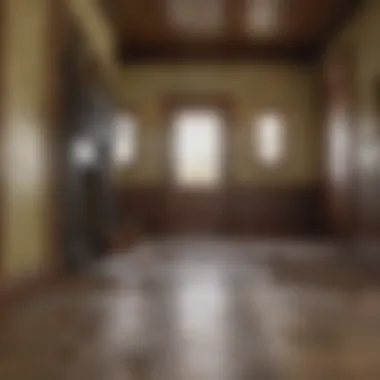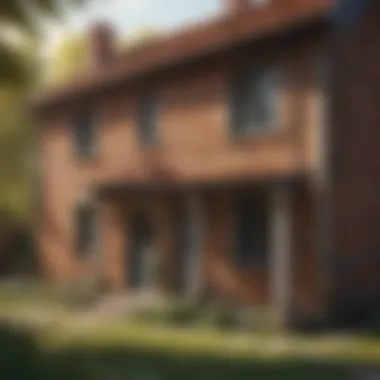Understanding Radon in Old Houses: Health Risks and Solutions


Intro
Radon is a naturally occurring gas that often goes unnoticed in many homes, especially older ones. Its sources lie deep within the earth, where uranium decays over time. As radon gathers in basements and lower levels of homes, it can reach concerning concentrations. High levels of exposure to radon can lead to serious health complications, including lung cancer. Although modern houses tend to have better radon prevention measures, the risk remains significant in older properties.
As radon detection and mitigation grow in importance, it's crucial for homeowners to understand the intricacies of this potentially hazardous gas. This article will examine the processes involved in radon formation, explore its health effects, and provide insights into effective detection and mitigation strategies. Additionally, we will cover the policies and legalities concerning radon exposure, ensuring readers have comprehensive knowledge to protect themselves and their families.
Coverage Options
Understanding radon and its implications involves knowing how to protect yourself legally and financially. To properly manage the risks associated with radon, it’s important to look into coverage options through homeowner’s insurance.
Types of Coverage Available
Homeowner insurance generally doesn’t include radon damage directly. However, there are special rider options or policy endorsements that can provide coverage against radon-related issues. These include:
- Radon Mitigation Coverage: This covers the costs needed for radon removal systems if high levels are detected.
- Health Effects Coverage: Depending on your policy, this can cover health issues that arise from radon exposure, contingent upon documentation.
Liability Coverage Explained
Liability coverage is crucial; it protects against lawsuits related to health risks from radon exposure. If a homeowner fails to mitigate high radon levels, they could be subject to legal action if someone gets sick. It’s prudent to evaluate your policy for liability specifics regarding radon.
Key Considerations
As a homeowner, certain factors must be considered to make informed decisions regarding radon risks and insurance policies.
Factors to Assess When Choosing Insurance
- Policy Details: Check if radon exposure is included in your insurance policy definition.
- State Regulations: Laws on radon liability can vary significantly from state to state.
- Home Age: Older houses are particularly vulnerable, so assess the risks accordingly.
Understanding Policy Limits
Every insurance policy has limits on how much they will pay out for certain claims. Knowing these limits is crucial for determining whether you have adequate coverage for potential radon exposure claims. Be sure to review any exclusions and understand how they might affect you in the case of a radon-related issue.
"The first step in protecting oneself from radon is being informed. Awareness is a key factor in potentially preventing health risks associated with this gas."
The intricate relationship between radon and homeownership speaks to broader health and safety issues. By understanding your coverage options and policy nuances, you can ensure better protection for you and your family.
Foreword to Radon
Radon is a topic that often escapes the attention of homebuyers and owners alike. Yet, its significance cannot be overstated. In older homes, radon gas can accumulate in dangerous amounts, leading to serious health implications. Understanding radon is essential for homeowners who wish to safeguard their living environment. This section will explore several key elements about radon, emphasizing its definition and the processes that lead to its formation.
Definition of Radon
Radon is a naturally occurring radioactive gas that is colorless and odorless. It originates from the decay of uranium, which is found in soil and rock everywhere. When uranium breaks down, it releases radon gas into the air and can infiltrate buildings through cracks in floors and walls, construction joints, and even gaps in the foundation. The presence of radon is more common in places with high uranium concentrations.
According to the Environmental Protection Agency (EPA), radon is the second leading cause of lung cancer in the United States, right after smoking. Therefore, knowing what radon is helps in taking action to limit exposure.
How Radon Forms
The formation of radon is a natural geological process. As uranium decays in the ground over time, it transitions through several radioactive elements before ultimately forming radon gas.
- Source of Uranium: Radon gas production begins with uranium, typically located in soil and rock formations. Various geological conditions can lead to higher amounts of uranium present in specific areas.
- Radiation Decay Process: As uranium breaks down due to radioactive decay, it transforms into various elements such as radium and through additional decay, ultimately becomes radon.
- Gas Migration: Once produced, radon is released from the ground into the surrounding air. It is important to note that it can easily move through soil and enter homes, particularly in basements or lower levels that are close to the ground. This underscores the necessity of understanding radon's formation, especially for owners of older houses.
By grasping these basic principles about radon and its origin, homeowners can better appreciate the potential risks and act accordingly. Monitoring for radon and implementing safety measures can profoundly impact one’s health, making this topic a critical aspect of home maintenance.
Radon and Older Homes: A Correlation
Understanding the relationship between radon and older homes is crucial. Many older houses were built using materials and techniques that can inadvertently foster the accumulation of this hazardous gas. Recognizing these factors empowers homeowners to take informed actions regarding radon testing and mitigation. For families living in historic homes, knowledge of radon's potential presence marks an important aspect of home safety and health.
Historical Context of Building Materials


Older homes often incorporate materials such as concrete, brick, and stone. These materials can vary significantly in their porosity, leading to differences in how radon gas can infiltrate indoor spaces. For example, homes built on or near soil rich in uranium deposits may have a higher potential for radon exposure due to gas being naturally released from the ground.
Moreover, aging buildings can suffer from structural deficiencies. Cracks in foundations, unsealed joints, and inadequate ventilation contribute to radon entry. Many homes built decades ago do not adhere to current building codes, which increasingly emphasize radon-resistant design principles. A homeowner must consider the integrity of their structure and any gaps that might allow radon to enter.
Common Radon Entry Points in Old Houses
It is essential to identify where radon could enter an old house. Here are common entry points:
- Basements: Most radon enters homes through the basement. Because they are typically in contact with the ground, they are more prone to radon exposure.
- Cracks in the foundation: Even small fissures can allow radon to seep in. Homeowners should inspect foundations for visible cracks and small gaps.
- Unsealed joints: Areas where different materials meet can sometimes provide a pathway for radon. It’s crucial to ensure joints are properly sealed.
- Sump pumps: If a home has a sump pump, it can help facilitate radon entry unless adequately sealed.
- Crawl spaces: These areas, often neglected, can also act as entry points for radon, particularly if they are not well-ventilated or sealed.
Awareness of these common entry points can guide homeowners in both testing and mitigation efforts. Sealants, ventilation systems, and professional radon reduction systems can effectively address these vulnerabilities to reduce radon levels within the home.
Health Risks Associated with Radon Exposure
The health risks of radon exposure are an important aspect of understanding this gas, especially for homeowners and residents in old houses. Radon is a known carcinogen, and the potential danger it poses cannot be understated. Both short-term and long-term exposure can lead to serious health issues. In this section, we will delve deeper into the specific risks associated with radon, particularly focusing on lung cancer and other long-term consequences of exposure.
Understanding Lung Cancer Risks
Radon is the second leading cause of lung cancer after smoking. This risk is compounded in older homes, where radon levels may be significantly higher due to outdated building materials and insufficient ventilation systems. The World Health Organization states that radon exposure causes thousands of lung cancer deaths each year. Even a small amount of radon can increase lung cancer risk over time.
The mechanism behind radon's carcinogenic effect is tied to its decay products. When radon gas is inhaled, it can release particles that damage lung tissue. Frequent exposure to high levels of radon can lead to significant cellular changes, ultimately resulting in cancer. It is critical for residents of old houses to be aware of these risks and take informed actions regarding testing and mitigation.
"The risk of lung cancer increases with the concentration of radon in the home and the duration of exposure."
Long-Term Health Consequences
Beyond lung cancer, the long-term health effects of radon exposure remain a topic of ongoing research. Some studies suggest a link between prolonged exposure to radon and other respiratory ailments, including chronic obstructive pulmonary disease (COPD) and other lung diseases. While the primary concerning health risk remains lung cancer, the potential for additional respiratory issues warrants attention as radon levels persist.
Furthermore, individuals exposed to radon in childhood face an increased risk of developing lung cancer later in life. This makes it especially important for families living in older homes to prioritize regular radon testing. Individuals may not even realize they are at risk until serious health issues arise.
In summary, recognizing the significant health risks associated with radon is crucial for homeowners. Being aware of lung cancer risks and other potential long-term health consequences allows for better preparedness and mitigative action, ensuring safer living environments.
Testing for Radon in Your Home
Testing for radon in your home is a crucial step towards ensuring the safety of its inhabitants. Radon, being colorless and odorless, often goes undetected until significant health issues arise. Regular testing helps identify potential radon levels, offering homeowners the chance to address the problem before it escalates.
The importance of testing cannot be overstated. With many homeowners unaware of radon as a health hazard, comprehensive testing can lead to timely interventions. It is also worth mentioning that different testing methods suit varying needs and circumstances.
Types of Radon Testing Methods
Understanding the methods available for testing radon is vital. Each technique has its advantages and limitations, making it important for homeowners to choose one that best suits their situation. Here are the primary options:
Short-Term Testing
Short-term testing is often the first step many homeowners undertake. This method is characterized by its quick results, typically providing readings within a few days to a week. People prefer this method mainly because of its immediacy. It requires minimal setup, making it accessible.
A unique feature is its use of detectors that can evaluate radon levels in a specific area for a short duration. However, while short-term testing is beneficial for a quick assessment, it may not be the most effective for gauging long-term exposure risks.
Long-Term Testing
Long-term testing focuses on identifying radon levels over an extended period, usually three months or more. This method is beneficial for understanding the baseline radon concentration in a home. It helps homeowners see what happens across different seasons, providing a detailed view of the situation.
The primary characteristic here is durability; detectors are left in place to accumulate data over time. Long-term testing gives a better picture of health risks associated with prolonged radon exposure. However, the downside is that the results will not be available immediately, which may be a concern for some homeowners needing timely information.
Continuous Monitoring
Continuous monitoring takes radon testing a step further by using electronic detectors that provide real-time data. This method is especially effective for homes where occupants require constant awareness of air quality. The key feature is the alert system that notifies homeowners of rising radon levels, allowing them to take action immediately.
While continuous monitoring offers a high level of reassurance and detail, it does have a higher initial cost due to the technology involved. These devices can also require occasional maintenance and calibration to ensure accuracy.
When to Test


Homeowners should consider testing their homes for radon:
- During real estate transactions: It's essential for buyers to know if radon levels pose a risk.
- After major renovations: Changes can disturb radon pathways.
- Every few years: Regular checks help maintain a continuous awareness of radon levels.
- In specific geographic areas: Some regions naturally have higher radon levels, making routine testing critical.
Regular testing is key to keeping your home safe from radon exposure.
Mitigating Radon Risks
Mitigating radon risks is crucial, especially for homeowners living in older houses. A home that has elevated radon levels can compromise the health of its residents. The importance lies not only in safeguarding inhabitants against potential health hazards but also in ensuring compliance with local laws regarding radon exposure. The presence of radon gas can be a silent danger, as it is often undetectable without proper measurement equipment. This section will delve into the various methods for mitigating radon, clearly explaining the benefits and considerations involved in each approach.
Professional Mitigation Systems
Engaging a professional for radon mitigation offers peace of mind. Such systems typically involve the installation of specialized equipment designed to reduce radon levels effectively. Professionals assess the home’s specific layout and foundation type, which helps in tailoring the best mitigation strategy.
Key benefits of professional systems include:
- Expert assessment: Trained professionals can identify radon sources and entry points, ensuring a comprehensive approach to mitigation.
- System reliability: Professional installations tend to be more reliable and efficient, often utilizing fans and ventilations to draw radon out of the home effectively.
- Long-term solutions: Well-installed systems provide sustained protection over time, rather than temporary fixes.
When considering professional help, it is advisable to verify their credentials and experience. A reputable installer should provide documentation and follow-up services to ensure continuous effectiveness of the mitigation system.
DIY Mitigation Strategies
For some homeowners, DIY radon mitigation can be an appealing option, especially for those who prefer to take matters into their own hands. There are simple measures that can be enacted to help reduce radon levels in homes. Starting with an inexpensive test kit can determine baseline radon levels before any mitigation strategies are undertaken.
Popular DIY strategies include:
- Sealing cracks: Use caulking or sealant to fill in cracks in walls, floors, and around service pipes. This can limit the entry points for radon.
- Improving ventilation: Ventilation not only can dilute indoor radon but also enhance indoor air quality overall. Opening windows and using fans can help.
- Sub-slab depressurization: This involves placing a PVC pipe with a fan below the slab to create negative pressure, drawing radon from below the home, and releasing it outside.
While DIY work may save money, it is essential to be aware of its limitations. These efforts might not completely eliminate radon but can significantly lower concentration levels. Moreover, if methods do not achieve desired results, it may be best to consult a specialized professional.
Important: Regular monitoring after any mitigation efforts is vital. Homes can still see fluctuations in radon levels due to changes in environmental conditions.
Understanding both professional and DIY strategies is essential for effective radon mitigation. By weighing the pros and cons of these options, homeowners can better navigate the best path for their unique situations.
Legal and Regulatory Considerations
When dealing with radon in old houses, understanding the legal and regulatory landscape is crucial. Homeowners must recognize their responsibilities and the potential implications of radon exposure. Laws and regulations surrounding radon exist to protect the public. They foster transparency and encourage proactive measures in property transactions.
Radon Disclosure Laws
Radon disclosure laws vary from one region to another. These laws often require sellers to inform potential buyers about radon levels in a property. In some states, sellers must provide a radon test result and disclose any mitigation systems in place. This transparency is valuable for buyers, allowing them to make informed decisions regarding their prospective homes. Falling short of these requirements can lead to legal consequences for sellers, making adherence essential.
Homeowners should be aware of their local laws. Resources like Wikipedia can offer insights into specific legal obligations based on geographical location. Understanding these regulations empowers individuals to protect themselves and their investments effectively.
Property Transactions and Radon Testing
In property transactions, radon testing becomes critical. Buyers, sellers, and real estate agents should prioritize radon checks during the buying process. A radon test can reveal the safety of a home before closing the deal.
Many buyers include radon testing in their contracts. This strategy ensures they are aware of potential risks. If elevated radon levels are found, buyers have options. They can negotiate for remediation before finalizing the sale.
However, some states do not mandate testing. In these cases, buyers should proactively seek radon evaluations. Conducting a radon test may uncover raw data vital for safety and future planning. Awareness of testing procedures offers a comprehensive approach to health and legal assurance.
In summary, engaging in the legal aspects of radon safety fosters a culture of awareness and responsibility in property transactions. Homeowners and prospective buyers alike should familiarize themselves with their rights and obligations regarding radon exposure.
Comparative Analysis of Radon Levels
Understanding the variances in radon levels across different regions is crucial. This section highlights how regional differences can influence radon concentrations in older homes. Homeowners must grasp the geographical context to effectively address this hazard.
Regional Variances in Radon Concentration
Radon levels can vary significantly based on location. Geological factors largely shape these differences. For instance, regions with high uranium content in the soil tend to exhibit elevated radon levels. Areas like Colorado and Pennsylvania often report higher radon concentrations compared to states with less uranium in their geology.


Homeowners can access state-specific radon maps to get a clearer picture of potential risk. It is important to recognize that even within a locality, radon levels can fluctuate between properties. Some homes may have basements that trap more radon due to their structural differences or proximity to bedrock.
- Local Soil Composition: The makeup of the local soil plays a major role.
- Historical Mining Activity: Places where uranium was mined may have lingering radon effects.
- Elevation: Higher altitudes can also correlate with increased radon.
Comparative analysis helps homeowners realize that testing is not a one-size-fits-all solution. Understanding local data is an essential first step to maintaining a safe living environment.
Impact of Geography on Radon Levels
Geographical factors heavily influence radon gas accumulation. Mountains, valleys, and water bodies create varied environmental conditions. Homes built in geologically sensitive areas often face higher radon risks. Structures located in basements or near the foundation interface with the earth, making them prone to radon infiltration.
Additionally, weather patterns can impact radon levels. For example, in colder months, homes are sealed better to retain heat, which can trap radon inside.
Key elements include:
- Soil Type: Some soils allow radon to escape more easily, while others do not.
- Building Codes: Local regulations can affect construction practices that may mitigate radon entry.
- Airflow: Ventilated homes generally have lower radon levels due to better air exchange.
To manage radon exposure, it is advisable for homeowners to familiarize themselves with both regional and geographical considerations. By doing so, they can make informed decisions around testing and mitigation strategies.
Community Awareness and Resources
Community awareness about radon and its health implications is crucial, especially for homeowners in older houses. Many people underestimate the risks posed by radon gas, thinking it is not a significant concern. This perception can lead to inadequate testing and insufficient mitigation efforts. When communities understand radon's dangers, individuals can make informed decisions regarding their homes and health.
Educational initiatives can play a vital role in raising awareness. They can inform homeowners about radon testing and its importance. People are less likely to be aware of radon's presence, particularly if they live in areas with higher radon levels due to geological conditions. Knowing more about radon can encourage individuals to take meaningful action against exposure.
Raising awareness also involves sharing resources. Communities can benefit from local organizations providing information, support, and resources. Such organizations can inform residents about testing kits, professional services, and legal requirements concerning radon. This proactive approach can lead to improved health outcomes and foster a sense of collective responsibility among community members.
Educational Programs on Radon Awareness
One effective method for enhancing community awareness is the implementation of educational programs focused on radon. These programs can take various formats like workshops, seminars, or informational webinars. They can help demystify radon and its potential effects.
Participants can learn about the following:
- What radon is and how it enters homes.
- The health risks associated with prolonged exposure.
- The importance of regular testing.
- Local regulations regarding radon.
Such educational programs also create a platform for questions and discussions. This can lead to greater engagement among participants. People can share their experiences and concerns associated with radon, making the information more relatable and actionable.
Support Groups and Resources for Affected Individuals
A key aspect of dealing with radon exposure involves emotional and psychological support for affected individuals. Support groups can provide an avenue for those managing the health implications of radon exposure. Participants can exchange experiences and coping strategies. This sharing often alleviates feelings of isolation common among those who face health risks.
Additionally, resources are available for those looking for help after discovering elevated radon levels in their homes. Local community organizations, state health departments, and even online forums can be valuable sources of information. For example, platforms like Reddit often feature discussions around radon experiences and mitigative solutions.
Furthermore, support groups can connect individuals with professionals skilled in radon mitigation. Access to qualified experts can accelerate the process of making homes safer.
"Awareness and support are key in addressing radon exposure. By fostering community knowledge, we empower individuals to protect their homes."
In summary, enhancing community awareness about radon is vital for promoting safety in homes, particularly in older houses. Educational programs and support groups play necessary roles in informing and assisting individuals affected by radon gas.
End and Recommendations
In the context of this article, the conclusion serves as a vital component to underscore the risks and necessary actions related to radon in old houses. This section ties together the previously discussed elements, allowing homeowners to fully grasp the significance of understanding radon and its impact on health and property safety. By synthesizing the information on radon testing, mitigation strategies, and community resources, this section clarifies the key takeaways and emphasizes the urgency of addressing radon issues.
Summary of Key Points
- Radon Characteristics: Radon is a naturally occurring, colorless, and odorless gas resulting from uranium decay. It is crucial for homeowners to recognize its properties.
- Health Risks: Prolonged exposure to radon significantly increases the risk of lung cancer. Understanding these health implications is essential for individuals residing in older homes.
- Testing Methods: Various testing options are available, including short-term, long-term, and continuous monitoring. Homeowners should choose methods that suit their needs.
- Mitigation Options: Both professional systems and DIY strategies exist to reduce radon exposure. Considering the specific needs of a property helps determine the best approach.
- Regulatory Awareness: Familiarity with local laws regarding radon disclosure can affect real estate transactions and community health.
- Community Resources: Numerous educational programs and support groups are available for homeowners looking to understand more about radon and its effects.
"Understanding radon is not just an individual concern. It reflects community health and awareness."
Future Considerations for Homeowners
Homeowners should remain proactive about radon risks. Regular testing is crucial, especially for those in regions with known radon issues. Advances in technology may lead to more effective and real-time monitoring devices, making it easier to manage radon levels.
Consider the following:
- Regular Testing: Make radon testing a part of routine home maintenance, just like checking smoke detectors or changing air filters.
- Educate Family and Friends: Share knowledge about radon and its potential risks with others to foster a community approach to safety.
- Stay Informed about Regulations: Keep updated on any changes to local laws related to radon exposure and testing. Understanding these regulations can aid in property transactions effectively.
- Engage with Community Resources: Utilize local health services or environmental organizations to stay informed about radon research and community initiatives aimed at reducing exposure.
It is not just about protecting oneself; it is also about contributing to the overall safety and awareness within the community.



